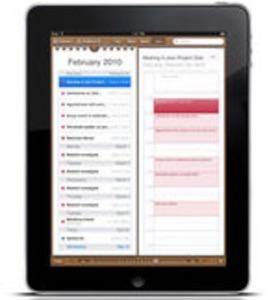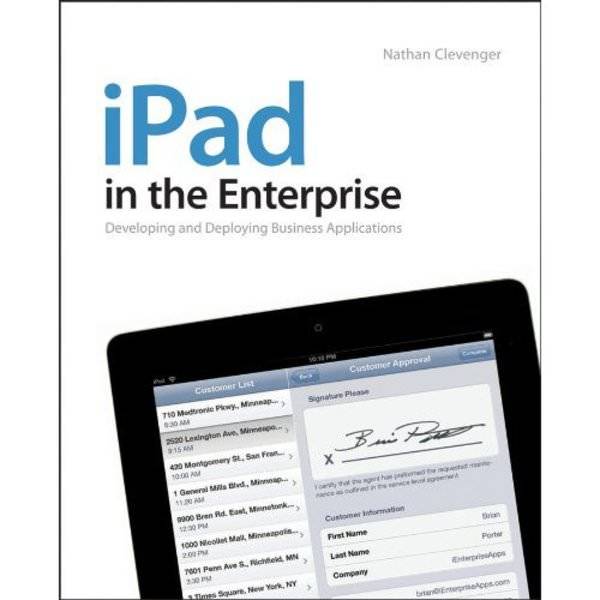In a forthcoming book from Wiley entitled iPad in the Enterprise, Nathan Clevenger cites several examples where the iPad has begun to transform the way that enterprise IT departments are operating. He does copious research and cites a series of intriguing examples where companies are tolerating, using, and even embracing iPads as part of their computing strategies. Here are a couple of excerpts from his research for the book.

Certainly, the notion of corporate workers purchasing their own PC equipment and using it for work purposes has been happening almost since the invention of the PC itself. When I was working for a large insurance company back at the dawn of the PC era, we had people even then buying their own printers, apps, and even PCs trying to connect to the corporate network. Of course, back in the 1980s, PCs cost more than $1,000, networks were wired via coax to IBM mainframes and apps came on 5 ¼” disks. But still, the daring few persisted.
With the iPad and other consumer devices, things have changed. Within 90 days of its introduction, half of the Fortune 100 companies had them on their networks. But so what? Clevenger quotes Kate Bass, the CIO at Valspar, saying, “Personally, I think that the fact that 50 percent of FORTUNE 100 have adopted the iPad is a gross overstatement. Yes, we have iPads in the organization but that does not mean widespread adoption nor that iPads are being used for daily processes. They work great for ‘consuming’ information that is available to the ‘consumer.’ They do not work well for creating information. I do think that they introduce an imperative, however, for the ERP vendors to make it easier to ‘consume’ data that we have spent years locking up in Fort Knox databases and storage systems.”
CIOs don’t have much choice anymore, as seen in another story he cites in his book:
“The day the iPad was introduced we had some discussions about adding them into our environment; 24 hours later, we had 500 devices accessing e-mails,” said Frank Modruson, the CIO of Accenture. “CIOs who resist will eventually be forced to change. Consider, for example, when the personal computer arrived on the scene. Its initial target market was the home. And then people started to recognize that PCs were very powerful tools that could be used at work. Many CIOs and procurement departments declined to authorize their purchase. So people circumvented the restrictions by saying they were purchasing a calculator. CIOs should not be asking if they should be taking advantage of the devices. They should be asking how they can take advantage.”
“As we move forward into a world where cloud enabled networks are the norm,” says Art Glasgow, the CTO at Ingenix, “CIOs have to accept the fact that the world has changed. Any device at any time on the network will be the norm and it will have to be done without sacrificing security and manageability. Cool matters and usability rules the day so devices like the iPad have to be not just accounted for, but designed for. The good news is that devices like the iPad aren’t just cool. They are flexible, multifunction tools that are changing the way we work and create and in that sense may very well be not just an innovation themselves, but a catalyst to innovations.”
One example cited in the book is the experience of media guru and NYU faculty Clay Shirky on a trip to his dentist, who “handed me an iPad to check in and update my information. The usual, horrible ‘We know we’ve seen you 20 times, but here’s a clipboard’ experience was transformed. Any data they already had was filled in, so I only had to add or alter new things. Even more interesting, the app for this was the web browser — this was a web interface to a cloud-hosted application, running via the office’s local Wi-Fi.
The iPad’s adoption has been like a cork popping out of a champagne bottle in part because of the pent-up demand it unleashes in other areas as well. The dental app wouldn’t have worked without good web design, cloud-hosted apps, local Wi-Fi, [and] a whole host of technologies that were worth less than the sum of their parts before there was a working tablet you could hand someone and have it just work. And the real kicker for businesses is that these kinds of uses don’t just act as replacements for PCs and laptops, they replace clipboards, paper, [and] local databases, and all kinds of inefficient practices get smoother and better”.

He mentions that Royal Caribbean Cruises is using iPads in a dozen different ways, both for their own internal processes as well as to enhance the experiences of their guests. “So I would disagree that enterprise IT is having trouble coming to grips with the onslaught of mobile technology now available,” Clevenger cites Bill Martin the cruise line’s CIO as saying. “On the contrary, we’re embracing it and trying to apply unconstrained thinking to find new ways to leverage it. From our perspective we say, ‘Bring it on.'”
Does this mean the traditional corporate desktop will disappear? Hardly. There are still some challenges. Thomson Reuters’ Mobile Technology Director Dan Bennett is more of a realist and Clevenger cites him saying that there are two in particular: “Immediately, IT must determine how to provide secure access to enterprise resources — this is distinctly non-trivial. Longer term, the mediocre user experience of the typical enterprise app must be improved if one is to translate the gains of consumerization to business value.”
The book will be available in August. Clevenger is Enterprise Editor for iPhone Life magazine, and also the Chief Software Architect at consultancy ITR Mobility.










